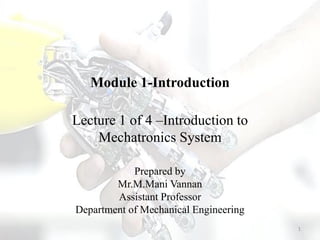
Mechatronics-Introduction to Mechatronics System
- 1. Module 1-Introduction Lecture 1 of 4 –Introduction to Mechatronics System Prepared by Mr.M.Mani Vannan Assistant Professor Department of Mechanical Engineering 1
- 2. UNIT I INTRODUCTION Introduction to Mechatronics – Systems – Concepts of Mechatronics approach – Need for Mechatronics – Emerging areas of Mechatronics – Classification of Mechatronics. Sensors and Transducers: Static and dynamic Characteristics of Sensor, Potentiometers – LVDT- Capacitance sensors – Strain gauges – Eddy current sensor – Hall effect sensor – Temperature sensors – Light sensors. 2
- 3. Mechatronics Mechatronics basically refers to mechanical electronic systems and normally described as a synergistic combination of mechanics, electrical, electronics, computer and control which, when combined, make possible the generation of simple, more economic, and reliable systems. 3
- 4. Key Elements of Mechatronics 4
- 5. 1-Information Systems a - Modeling and Simulation Modeling is the process of representing the behavior of a real system by a collection of mathematical equations and logic. Simulation is the process of solving the model and it is performed on a computer. The process of simulation can be divided into three sections: 1.Initialization, 2.Iteration, and 3.Termination 5
- 6. 1-Information Systems c - Optimization Optimization solves the problem of distributing limited resources throughout a system such that pre specified aspects of its behavior are satisfied. It is applied to: 1.Establish the optimal system configuration 2.Identification of optimal trajectories 3.Control system design 4.Identification of model parameters 6
- 7. 2- Electrical Systems The following electrical components are frequently used: - Motors and generators - Transducers - Solid state devices including computers -Circuits (signal conditioning, impedance matching, amplifiers…) -Contact devices (relays, circuit breakers, switches…) 7
- 8. 3-Sensors Sensors are required to monitor the performance of machines and processes. Some of the more common measurement variables in mechatronics systems are temperature, speed, position, force, torque, and acceleration. The characteristics that are important when one is measuring these variables include the dynamics of the sensor, stability, resolution, precision, robustness, size, and signal processing. 8
- 9. 4- Actuators Actuation involves a physical acting on the process, such as the ejection of a workpiece from a conveyor system initiated by a sensor. Actuators are usually electrical, mechanical, fluid power or pneumatic based. They transform electrical inputs into mechanical outputs such as force, angle, and position. Actuators can be classified into three general groups. -Electromagnetic actuators, (e.g., AC and DC electrical motors, stepper motors, electromagnets) -Fluid power actuators, (e.g., hydraulics, pneumatics) - Unconventional actuators (e.g., piezoelectric, magnetostrictive, memory metal) 9
- 10. 5- Computer Systems Computer system hardware is usually restricted to computer-specific circuits and devices. These include logic networks, flip flops, counters, timers, triggers, integrated circuits, and microprocessors. -Assembly language was the first step toward a higher- Ievel language -For more powerful (higher-level) programming languages to be used, compilers were developed. Some of the most well-known high-level languages are BASIC, FORTRAN, C, and Pascal. -Visual languages, including Matrixx, EasyS, SimuLink, VisSim, and LabView. 10
- 11. 6- Real-Time Interfacing It is process of fusing and synchronizing model, sensor, and actuator information is called real- time interfacing or hardware-in-the-loop simulation. For mechatronics applications real-time interfacing includes analog to digital (A/D) and digital to analog (D/ A) conversion, analog signal conditioning circuits, and sampling theory. The main purpose of the real-time interface system is to provide data acquisition and control function for the computer. 11
- 12. System and its types A physical device or a mathematical model or a software. An Electronic System is a physical interconnection of components, or parts, that gathers various amounts of information together. Types of system: a) Based on control i)Open loop Control system ii)Closed loop Control system iii)Automatic control system b) Based on signals i)Continuous time systems ii)Discrete time systems 12
- 13. Open-loop Systems A open-loop system does not monitor or measure the condition of its output signal as there is no feedback. It measures only the output of the system. Characteristics: 1.There is no comparison between actual and desired values. 2.An open-loop system has no self-regulation or control action over the output value. 3.Each input setting determines a fixed operating position for the controller. 13
- 14. Closed-loop Systems Closed-loop Systems use feedback where a portion of the output signal is fed back to the input to reduce errors and improve stability. Characteristics: 1.To reduce errors by automatically adjusting the systems input. 2.To improve stability of an unstable system. 3.To produce a reliable and repeatable performance. 14
- 15. Continuous-time System A continuous-time system is one in which the input signals are defined along a continuum of time, such as an analog signal which “continues” over time producing a continuous-time signal. For example, the temperature of a room can be classed as a continuous time signal which can be measured between two values or set points 15
- 16. Discrete-time System A discrete-time system is one in which the input signals are not continuous but a sequence or a series of signal values defined in “discrete” points of time. This results in a discrete-time output generally represented as a sequence of values or numbers. For example, the temperature of a room measured at 1pm, at 2pm, at 3pm and again at 4pm without regards for the actual room temperature in between these points at say, 1:30pm or at 2:45pm. 16
- 18. Concept of Mechatronic Approach 18
- 19. Comparison between Traditional and Mechatronic Approach Sl.No Traditional Approach Mechatronic Approach 1. It is based on traditional system such as mechanical hydraulic and pneumatic It is based on mechanical , electronics, computer technology and control engineering 2. Less flexible More flexible 3. Less Accurate More accurate 4. More complicate mechanism in design Less complicated mechanism design 5. It involves more components and moving parts It involves fewer compounds and moving parts 19
- 20. THANK YOU 20